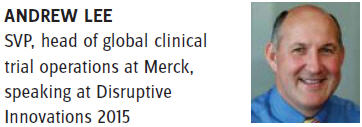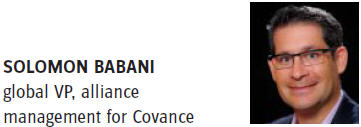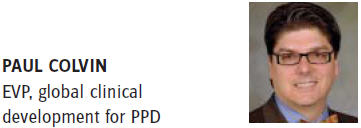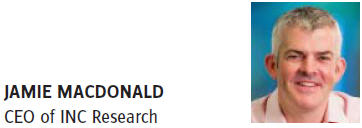What Will The CRO Of The Future Look Like?
By Ed Miseta, Chief Editor, Clinical Leader
The world of clinical trials is changing. New technologies are changing how trials are performed. The internet and social media have enabled greater patient connections, which will continue to change how patients are recruited. And Big Data, genomics, biosimilars, and precision medicine will change the industry in still unknown ways.
With all of the clinical work being outsourced, there is no question these changes will affect CROs as well. In fact, it makes you wonder what exactly the CRO of the future will look like.
"Our world has changed, and our way of getting the work done has changed. CROs started off as companies providing services for pharma companies in areas where they did not have a lot of volume. But since then they have transitioned more to providing services in niche areas, such as biostatistics, preclinical toxicity development, and assay testing. When these companies started spreading across the world, greater collaboration with Big Pharma companies came with that expansion. Nowadays they can even help companies to commercialize their products. We have gotten to the point where there is almost nothing they can’t do."

When major consulting firms started advising pharma companies to focus on their core competencies, that led many to strip down to just R&D, which consequently created the current trend toward strategic partnerships. Those partnerships have obviously pushed millions of dollars into the CRO space and made sponsors more dependent on CRO services.
But can all of this growth in the CRO industry continue? The largest growth right now seems to be in the biotech space, but the main factor poised to drive CRO growth in the future is whether or not service providers can adapt to pharma needs in the future. In fact, this concept of identifying and providing services for the future needs of the biopharma industry is exactly what will keep the CRO industry growing.
Solomon Babani, global VP, alliance management for Covance, believes there are hurdles CROs will need to overcome. In talking to biotech firms, he has found many of them do not believe the larger CROs have what it takes (or really care) to engage profitably with smaller companies. He now spends a lot of his time educating these companies not only on what they should be asking for, but how to ask for it.
"CROs have the capability to put fundamentally different types of teams in place; they just need to understand the needs of their clients,” he says. “We can customize a program to meet their development needs as long as companies are able to articulate what they need. The ability to put these teams in place has been enhanced by the ability of CROs to attract top talent. Now that CROs have that expertise, they are better able to design development programs for companies of any size."

IS TRUE STANDARDIZATION JUST A DREAM?
Paul Colvin, EVP, global clinical development for PPD, believes the time to change is now because the industry continues to see increased complexity, rising costs, and greater pricing pressures. According to Colvin, CROs and pharma must find ways of partnering to bend the cost and time curve.
"Competition in our business is normal and healthy. However, we should not compete around things like standardization of metrics and definitions, because that only drives inefficiency, duplication, miscommunication, and significant costs. The real competition should be around the best molecules, the strongest talent, and the creation of a system-agnostic development process that supports the seamless integration of best-in-class technology and disruptive innovations. But CROs cannot do it alone. It must be a collaborative effort across the entire drug development industry. It is our joint mission to improve the health of patients and lower the cost of development."

Colvin would like to see a level of standardization throughout the industry that would allow everyone to use the same set of metrics and definitions, which he says will allow for faster and better data integration and will set a clear baseline across all trials for improved predictive analytics. But is it possible to accomplish that true standardization?
The idea of a total integration is far more difficult today, he noted, because of the need to map all the different standards and definitions among systems. Doing so is extremely labor-intensive and weakens the overall quality of the analysis. At the same time, access to the plethora of data sources, such as from health networks, insurance payers, pharmacies, and patients, makes it ever more critical to have standards in place. And that standardization must include how to collect and integrate patient data.
While technology, standardization, and talent are key factors, Colvin says we must remain focused on the patient. He believes using a more patient-centric model will help to better engage and encourage patient participation in trials because of the greater convenience it will offer. “As an industry, we need to place even more emphasis on the patient, and as new technology and innovations are developed, we need to use them to improve the patient experience and their level of engagement,” he noted. Colvin feels significant progress can be made in that respect via such tools as mobile health, telemedicine, minute clinics, and patient concierges — all of which are helping to make it easier for patients and volunteers to participate in clinical trials and increasing the efficiency and effectiveness of conducting those trials.
Jamie Macdonald, CEO of INC Research, agrees standardization is important. He notes the CRO Forum is already in the process of collaborating with TransCelerate on several of their initiatives, in addition to working with other industry groups.
"TransCelerate is one part of this industry, but there are others. We will need to include and get the support of all of these groups, and we are making the linkages. If a common technology is going to be made available, and people are open to sharing it, then that certainly bodes well for the industry."

Still, Macdonald adds the real challenge for the industry is that, even with the best research and molecules, you still need to have motivated investigators with access to qualified patients. As we continue to move toward targeted medicines, the old paradigms of site identification and patient recruitment will not get sponsor companies the enrollment numbers needed in the necessary time frame to make trials more timely and efficient.
UNDERSTAND OUR CHALLENGES
So what are the critical challenges CROs face that they would like sponsor companies to better understand? The first would be for pharma to develop better relationships with the entire healthcare community. Or stated differently, how can we make clinical trials an option for all eligible patients? We all know it does not happen often enough. Data shows only 3 percent of physicians in the U.S. have ever been principal investigators, and half of those no longer work in research. “As a result, we are dealing with a very small pool of investigators,” says Macdonald. “The industry needs to stop its practice of rejecting investigators who have received a 483 without even knowing the reason for the warning. If a sponsor changes a protocol seven times, they shouldn’t be surprised if there is a protocol deviation. We need to do more to help these physicians succeed.”
Finding eligible patients who are comfortable participating in research and can adhere to the requirements of a protocol is also essential. A unified patient registry for each disease that can be shared by companies might be a step in the right direction. Changing patient perceptions of the industry is also critical. It should come as no surprise to anyone reading this article that the reputation of the pharma industry can oftentimes not be conducive to patients volunteering to participate in a trial.
Of course, the day will also come when sponsor companies become much more adept at collecting data, moving it around, and engaging potential patients. When that happens, will we eventually see a time when pharma discovers a new molecule and opts to work with Google or Apple, forgoing CROs altogether?
While Macdonald acknowledges that could very well be a reality in the future, he does not believe it will happen. “Innovation breeds more innovation,” he says. “IBM’s Watson is already working in the clinical space helping to identify patients. But the industry is still in need of an honest broker that will match a patient with the right physician and the right protocol. That will likely not be a sponsor company because they have too much of a vested interest. But I think it will happen with CROs or some other agents in that process.”
CROs partnering with labs that are more centrally located to patients is one example of how they can better assist pharma in connecting with patients. Babani notes when Covance and Lab Corp combined their companies in 2015, Covance gained access to a wealth of patient information. However, he says companies need to move forward with caution, since those patients will need to give permission for their samples to be used in clinical development. Still, the concept of allowing patients to visit local labs as opposed to traveling to physicians’ offices will be a win. In any trial, patients need to give blood, and CROs should do everything they can to make that process as easy as possible. It is also another way for CROs to distinguish themselves in the future.
Finally, having a CRO that can “think on its feet” and make the right decision when situations arise may also be a sought-after commodity. As a result, the days of the project manager at a CRO calling a sponsor to ask how a problem should be resolved may be a thing of the past. This is especially true as CROs continue to hire more personnel with experience in pharma and bio or who have a track record of having supported those companies.
While it might be hard to predict what the typical CRO will look like in five to 10 years, I don’t think the concept of CROs will go away anytime soon. But that doesn’t mean the role of the CRO can’t continue to change and evolve. Those that do the best job of meeting the needs of pharma companies, and even anticipating those needs before they arise, will be successful. They will also build confidence in the companies with which they hope to do business. Those partners that cease to bring value to sponsors or do not provide any more value than what the sponsors themselves bring will be the ones most likely to struggle.
